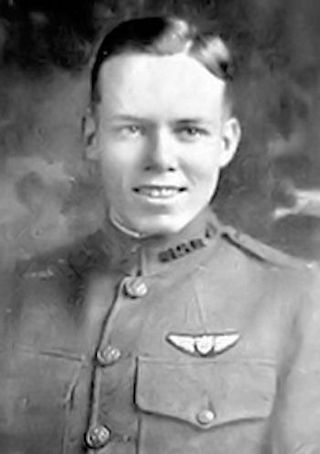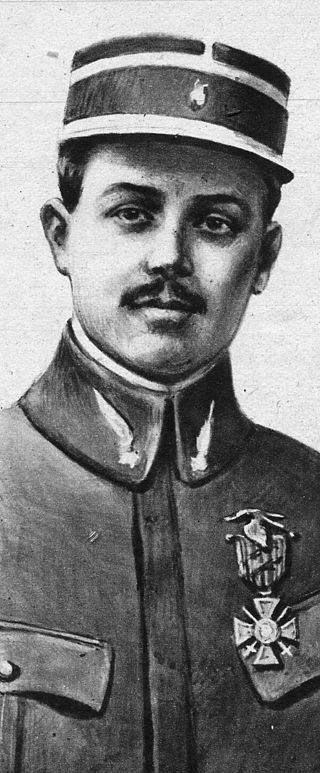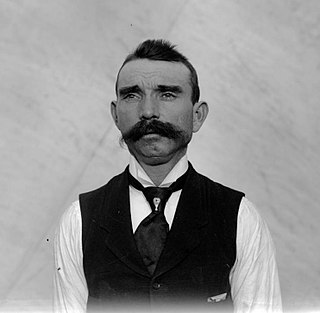
Frank Luke Jr. was an American fighter ace credited with 17 aerial victories, ranking him second among United States Army Air Service pilots after Captain Eddie Rickenbacker during World War I. Luke was the first airman to receive the Medal of Honor and first USAAS ace in a day. Luke Air Force Base, Arizona, a United States Air Force pilot training installation since World War II, is named in his honor.

Georges Guynemer was the second highest-scoring French fighter ace with 54 victories during World War I, and a French national hero at the time of his death. Guynemer's death was a profound shock to France.

The Nieuport 28 C.1, a French biplane fighter aircraft flown during World War I, was built by Nieuport and designed by Gustave Delage. Owing its lineage to the successful line of sesquiplane fighters that included the Nieuport 17, the Nieuport 28 continued a similar design philosophy of a lightweight and highly maneuverable aircraft.

Michel Joseph Callixte Marie Coiffard was one of the leading French flying aces of World War I. He was notable for his success as a balloon buster shooting down enemy observation balloons, which were usually heavily defended by anti-aircraft machine guns and artillery and by fighter planes. He scored 34 victories in his career.

The Colorado Aviation Hall of Fame was established by the Colorado Aviation Historical Society (CAHS) in Denver, Colorado, USA, on November 11, 1969 for the State of Colorado. The original and first ten Colorado aviation pioneers were inducted into the Hall on that date. Guest speaker for the event was author Ernest K. Gann. The Hall of Fame is part of the Society's Heritage Hall in the Wings Over the Rockies Air and Space Museum, Denver, Colorado.

The SPAD S.XII or SPAD 12 was a French single-seat biplane fighter aircraft of the First World War developed from the successful SPAD VII by Louis Béchereau, chief designer of the Société Pour L'Aviation et ses Dérivés (SPAD).

Reed McKinley Chambers was a pioneer in the American Aviation industry, as a flying ace in World War I, as founder of an early airline, and as founder and chairman of America's first aviation insurance company.

Major William John Charles Kennedy-Cochran-Patrick DSO, MC & Bar was a Scottish First World War flying ace, credited with 21 aerial victories. He was the leading ace flying the Spad VII fighter, and of No. 23 Squadron. He later flew aerial surveys on three continents.

Lieutenant Donald Hudson was an American World War I flying ace credited with six aerial victories. Postwar, he pioneered aviation in Bolivia, including being the first aviator to fly across the Andes Mountains.

Lieutenant Lansing Colton Holden, Jr. was a World War I flying ace credited with seven aerial victories.
Adjutant-Chef Antoine Laplasse was a World War I balloon buster and flying ace credited with eight aerial victories, six of which were against observation balloons.
Sous Lieutenant Jacques Louis Ehrlich (1893-1953) was a French World War I flying ace credited with 19 aerial victories; he was one of the leading balloon busters of the war.
George W. Thompson was a self-taught aviator, and is one of the first Coloradan flyers. He was born near Sharon Springs, Kansas. Thompson built a Mathewson biplane, a Curtiss design, and soloed it on January 4, 1911.

Capitaine Albert Louis Deullin was a French World War I flying ace credited with twenty aerial victories. He served for the entirety of World War I. By war's end, he had risen to command of a fighter wing. He would die in a postwar flying accident.

Lieutenant Frank Leaman Baylies was an American World War I flying ace credited with twelve aerial victories while flying in the French Aeronautique Militaire. Having originally volunteered for the Ambulance Corps, Baylies transferred into French aviation in May 1917. After scoring his 12 victories with the French, he transferred into American aviation service but remained with the French until his death in action.

The Organization of the Air Service of the American Expeditionary Force on November 11, 1918, represents its maximum strength in World War I. Units of the Air Service are listed as assigned to the order of battle for that date, which was that of the Armistice with Germany. The first air unit arrived in France in September 1917, while the final air unit reaching the front did so on November 9, 1918. Unit operations began in April 1918. At the armistice, 57,508 officers and men served in the Air Service of the AEF, 24,512 in the Zone of Advance, and 32,996 in the Services of Supply. Of its 6,861 officers, 4,088 were on flying status and 219 were qualified observation balloon aviators. 1,724 of those on flying status and approximately 100 of the balloonists served in combat units.
LeutnantHermann Habich (1895–?) was one of the original pilots in the Imperial German Air Service, having earned his brevet two months before World War I began. He is noted for having killed French aviation pioneer Roland Garros. Habich scored seven victories in all, becoming a flying ace. He joined the Luftwaffe in the 1930s and served in World War II.

Ivy Baldwin (born William Ivy July 31, 1866 – October 8, 1953, in Houston, Texas, he changed his name in later years to Ivy Baldwin so that he and his partner, Thomas Scott Baldwin, could be billed as "The Baldwin Brothers". Ivy Baldwin was an American balloonist, aeronaut and high-wire performer. He is credited with being the first aviator to be shot down during wartime in the U.S. during the Spanish–American War.
Allan F. Bonnalie (1893–1981) was an early aeroplane builder and aviator in Colorado, multi-medal recipient of World War I in 3 branches of military and created a comprehensive crew training program for United Airlines Flight Training Center, Denver.
Frank August Van Dersarl was a self-taught pilot and aircraft builder of early aviation the Colorado. Van Dersarl owned an aviation company, and taught flying; also owned the Denver Union Airport.














